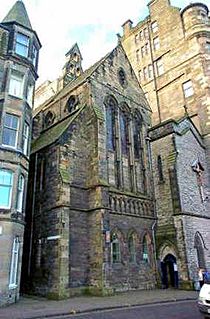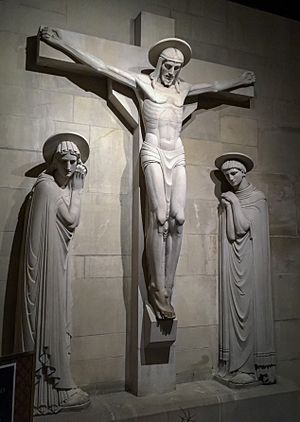Old St Paul's, Edinburgh facts for kids
Quick facts for kids Old Saint Paul's, Edinburgh |
|
|---|---|

Old Saint Paul's, Jeffrey Street, Edinburgh
|
|
| Denomination | Scottish Episcopal Church |
| Churchmanship | Anglo-Catholic |
| Website | http://www.osp.org.uk |
| History | |
| Dedication | Paul the Apostle |
| Administration | |
| Diocese | Diocese of Edinburgh |
Old Saint Paul's is a very old and important church in the heart of Edinburgh, Scotland. It belongs to the Scottish Episcopal Church. This church is special because it was one of the first groups to form the Scottish Episcopal Church. This church is part of a bigger family of churches called the Anglican Communion.
The people who first went to Old Saint Paul's were a group who left Saint Giles' Cathedral. Saint Giles' was the main church in Edinburgh at the time.
Contents
History of Old Saint Paul's Church
Even though the building you see today is from the 1800s, Old Saint Paul's has a history that goes back over 300 years. It started when the Scottish Episcopal Church itself began.
How the Church Began
The first group of people who formed Old Saint Paul's left St Giles' Cathedral. This happened in 1689. The last bishop at Saint Giles', named Alexander Rose, left with many of his church members. They started a new place to worship in an old wool store. This store was very close to where Old Saint Paul's stands now.
A Time of Change and Challenge
Many members of the Scottish Episcopal Church supported the Jacobites. The Jacobites were loyal to King James and his family. Members of Saint Paul's were involved in these struggles. This included events in 1715 and 1745. One church member even brought news of a victory to Edinburgh. He then helped close the town gates against the opposing army.
Because of these events, Episcopalians and their churches faced difficulties. Laws were made against them. These laws were slowly removed after 1788. This was when the connection between Episcopalians and the Jacobites became less strong. After this, Scottish Episcopal churches began to pray for the ruling monarch, King George III.
Growing and Expanding
In the 1820s, Old Saint Paul's became very crowded. Because of this, a new church was started in Broughton Place. This group later moved to the Inverleith area. A new church called St James, Goldenacre opened there in 1888.
The Church Building and Its Features
The current church building was finished in 1883. It was designed by architects Hay and Henderson. They used a style called "Early English." The building cost about £3500 to build. Hay had learned from a famous architect, Sir George Gilbert Scott.
Inside the Church
The church has been made longer two times since it was built. This has made it three times its original size. The floor near the main altar has been raised and covered with marble.
The main altar is made of carved oak wood. It has decorations that look like grapevines. On top of it is a special stone slab. Seven lamps near the altar represent the gifts of the Holy Spirit. Behind the altar is a beautiful gilded oak screen. It was designed in 1896. The tall, narrow windows show the crucifixion scene. They also show Saint Paul and Saint Columba. The church's roof has a special design called a "hammer beam" structure. It has wooden gargoyles. The pulpit, where sermons are given, is made of carved oak. It has figures of saints and was built in 1892.
The Memorial Chapel
A special chapel was built in 1926. It is called the Warriors' Chapel. It remembers the lives lost in the First World War. This chapel was organized by the church's leader at the time, Canon Albert Ernest Laurie. It holds lists of names from both World Wars.
This chapel also has a small iron cross called the Martyrs' Cross. This cross used to hang in the Grassmarket area. It was the last thing people saw before they were executed there. Today, the chapel usually displays a painting by Alison Watt. She is a Scottish artist.
Sculpture at the Calvary Stair
At the top of the Calvary Stair, there is a sculpture of the Crucifixion. This artwork was created by Alfred Frank Hardiman in 1926.
The Organ
The church's organ was built in 1888 by Father Henry Willis. Some small changes were made to it in 1936. In 1960, it was made electric and got bigger. It also received a new control panel with special buttons. More changes and additions were made to its sound in 1968.
The Church Hall
Underneath the church, there is a large hall. During the Edinburgh Festival Fringe, this hall becomes a performance space. It is known as theSpace @ Venue 45. It is run by a group called theSpaceUK.


